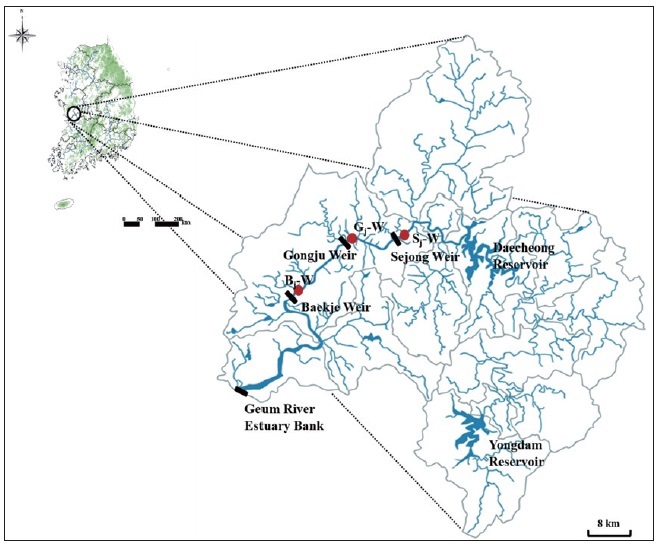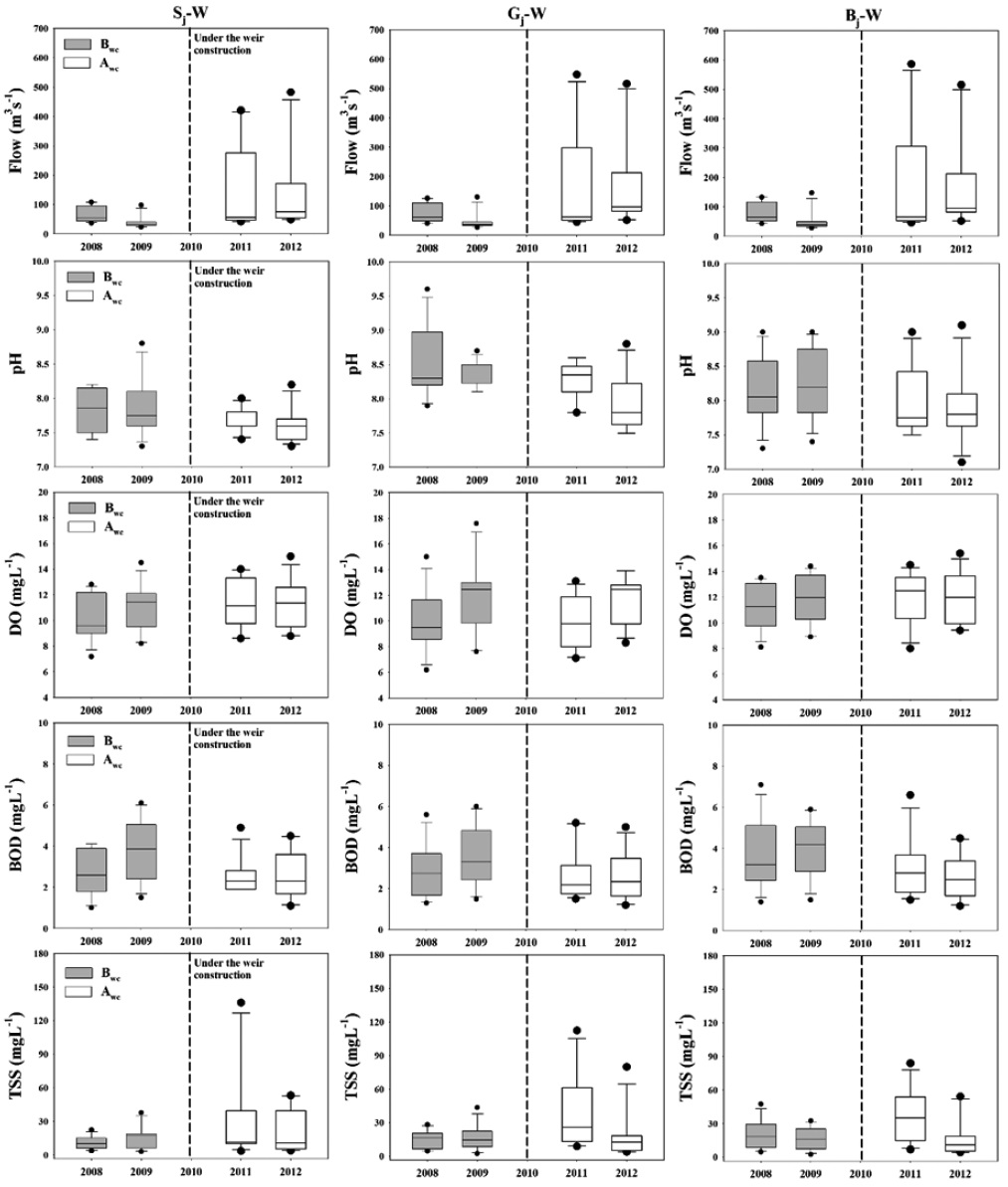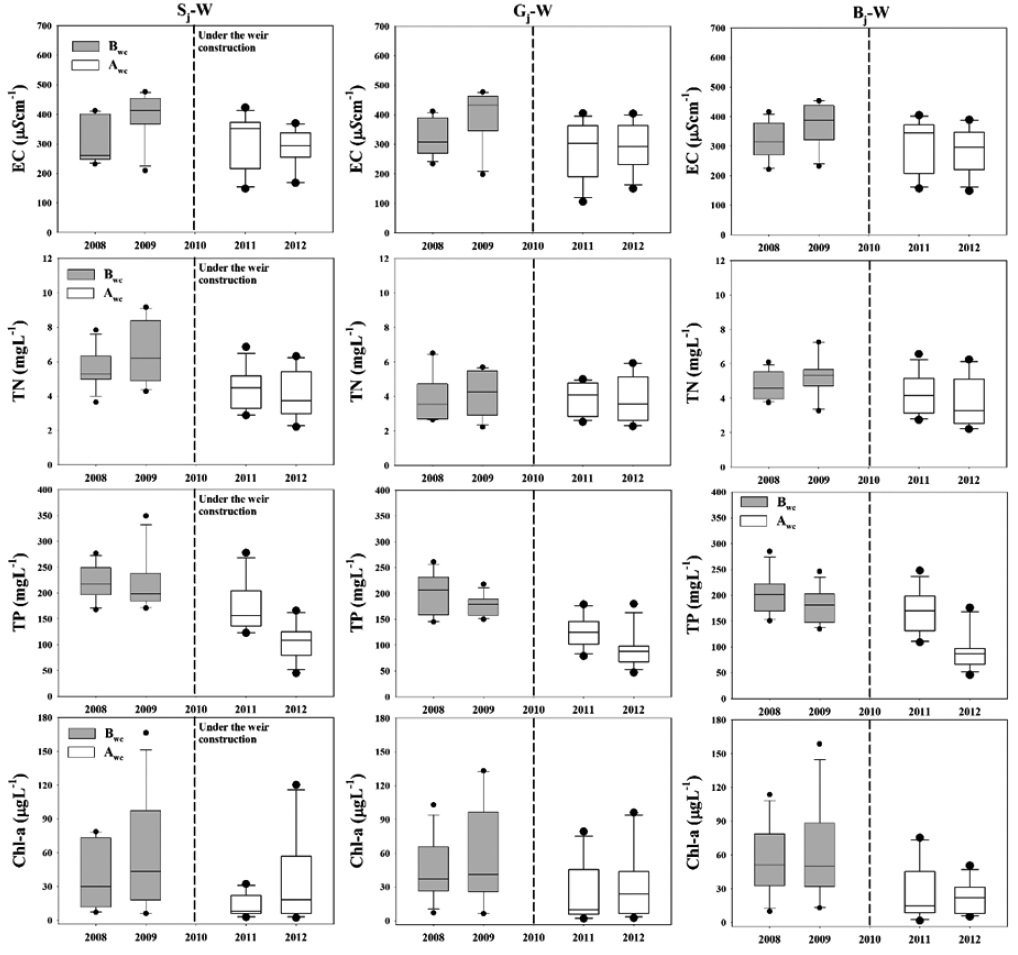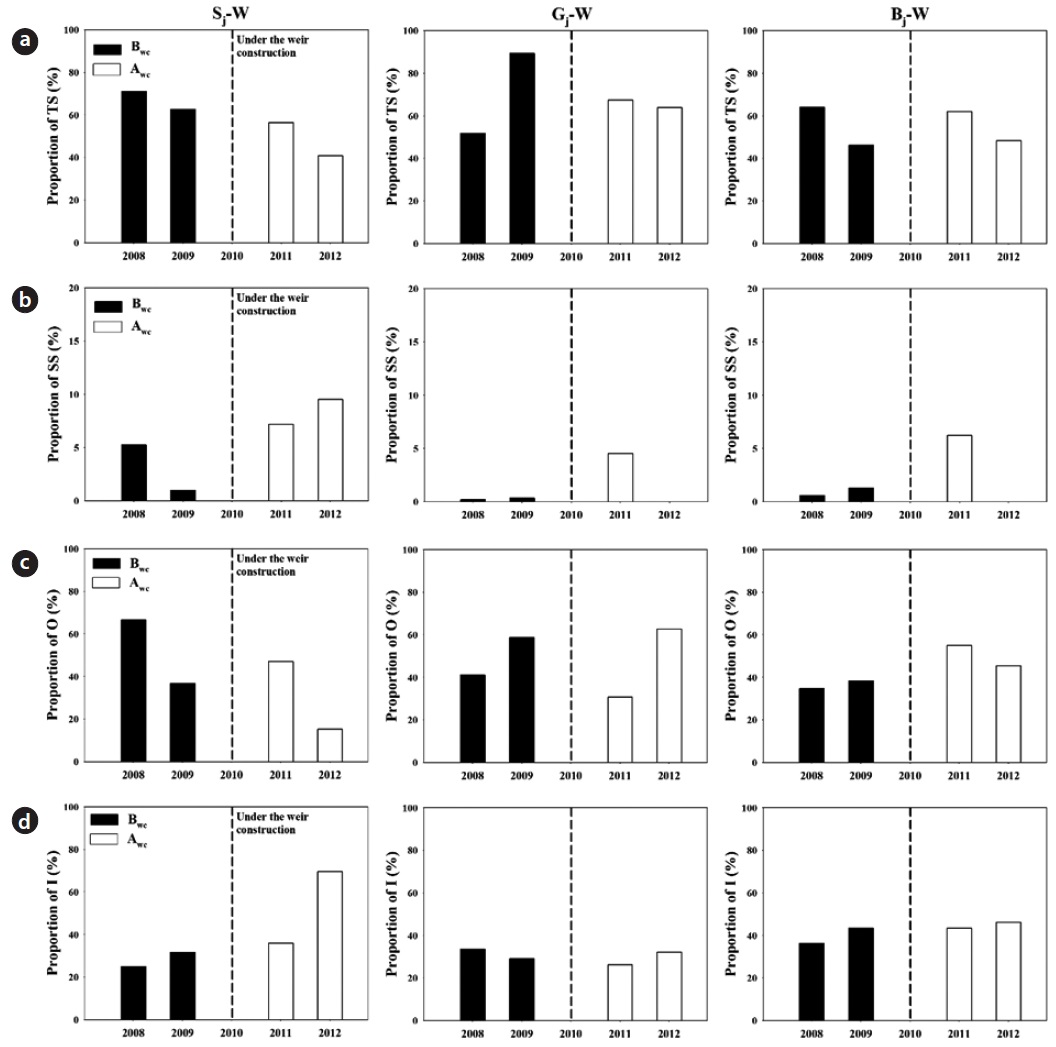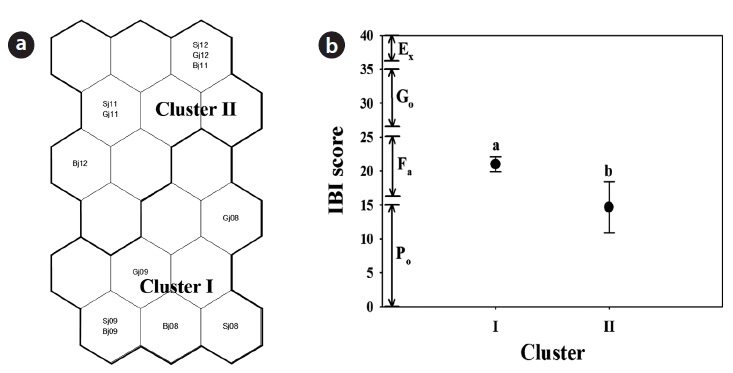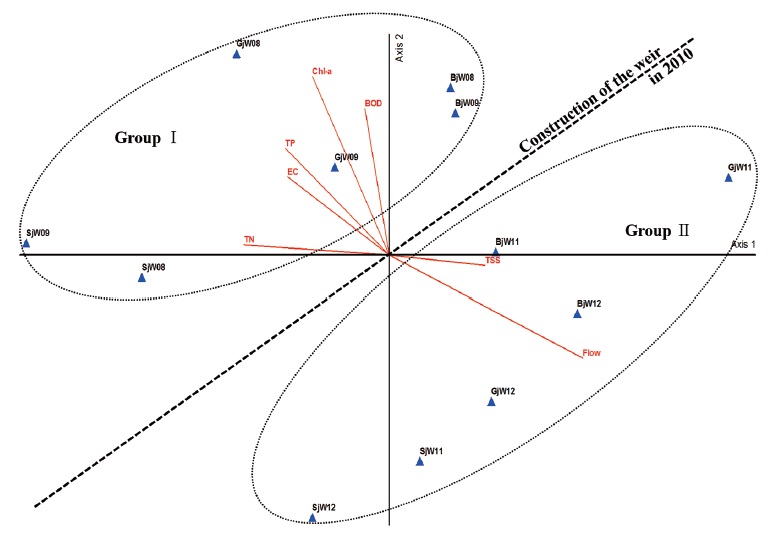



Large rivers have longitudinal gradients of chemical water quality and physical habitats from the headwaters to the downrivers near the estuary, resulting in structural and functional variations in riverine fish community (Schlosser 1982, Gelwick 1990). These gradients, however, may be interrupted by natural processes (Balon and Stewart 1983, Maret et al. 1997) or artificial constructions of dams or weirs on the rivers (Baxter 1977, Dynesius and Nilsson 1994, Richter et al. 1997). Thus, serial discontinuity concept (SDC) was hypothesized by Ward and Stanford (1983) who emphasized numerous impacts of physical, chemical and biological re-setting (Ward and Stanford 1979) by weir or dam constructions on the rivers.
The weir-construction or serial impoundment-induced changes in current velocity or inflow regime caused physical habitat alteration, with decreased flow velocities and high siltation rates near the upstream of weirs (Kondolf 1997) and increased flow velocities leading to substrate scouring downstream (Camargo and Voelz 1998). These habitat modifications create conditions favorable for exotic or non-native species (Marchetti and Moyle 2001), which can then further alter fish assemblage compositions via a predation and competition (Godinho and Ferreira 1998, Eby et al. 2006). Water chemistry in the river ecosystem is directly or indirectly influenced by the weir or dam constructions (Hannan and Young 1974). These influences on the water chemistry can either be spatially inflow of high nutrients, such as nitrogen (N) and phosphorus (P), from extensive crop lands, urban pipes or a wastewater disposal plant. Predicting inputs from the point sources is relatively simple, but attributing chemical factors of river water to non-point sources (NPS) is much more difficult (Baker 2003).
The weir constructions of Geum-River watershed, which belong to our study location, were initiated from the Korean government’s five-year national plan of “The Four Major Rivers Restoration Project” in July 2009. Recent studies of the weirs constructed in the region pointed out hydrological modifications of water retention time, current velocity (Kim 2013), chemical pollutions by rapid eutrophication, and biological impacts. Within the regions of weirs, the hypoxia near the bottom, frequent algal blooms, and surface scums were frequently observed along with massive fishkills, indicating an impacts of aquatic environments.
However, little is known about influences of the weir constructions on fish compositions and the community structure in this Asian region. Poff et al. (1997) pointed out that more intensive researches are required to understand functional and trophic modifications of fish community in impounded rivers. In this study, some influences of chemical water quality and fish community on the weir constructions were analyzed between the two periods of before- (2008 – 2009) and after the weir construction (2011 – 2012) within the Geum-River watershed. Also, tolerance guilds and trophic compositions of fish, as an ecological indicators, were compared along with river ecosystem health assessments, based on multi-metric fish model of index of biological integrity (IBI).
This study was conducted in the Geum River watersheds including mainstream regions, which is located in the midwest temperate region of South Korea (Fig. 1). Total three sites were selected for fish sampling where each site represents the characteristics of the weir-constructed area within 1 km upper region from the artificial weir constructed on the Geum River watersheds. It was consisted of every 3 sites of each weir region; Sejong-Weir (Sj-W), Gongju-Weir (Gj-W) and Baekje-Weir (Bj-W) and also conducted in premonsoon (May - June) and postmonsoon (September - October) in periods of before the weir construction (Bwc; 2008 - 2009) and after the weir construction (Awc; 2011 - 2012) respectively. All sampling was operated by the modified wading method (An et al. 2004) to adapt the Korean aquatic ecosystem based on the Ohio EPA method (1989).
For the fish sampling, we considered all habitat types such as riffle, run, and pool in the same site and directed in an upstream to downstream reach for at least 200 m distance during 50 minutes for the catch per unit efforts (CPUE). Casting-net (7 × 7 mm, CN) and kick-net (4 × 4 mm, KN), the most popular fish sampling gears in Korea, were applied to collect samples. All fishes were identified at the sampling place and released immediately. All specimens were identified according to classification keys of Kim and Park (2002).
>
Water quality analysis and stream ecosystem health assessment
Water quality data were obtained from the Water Information System (WIS) of the Ministry of Environment, Korea (MEK) during 2008 – 2012, except 2010 for physicochemical water quality analysis. Nine parameters such as water discharge (Flow), pH, dissolved oxygen (DO), biological oxygen demand (BOD), total suspended solids (TSS), total nitrogen (TN), total phosphorus (TP), electric conductivity (EC) and chlorophyll-a (CHL-a) were examined for the analysis. For the study, eight metric model of the Index of Biological Integrity (IBI) was applied, instead of original 12 metric model originally suggested by Karr (1981). The model was modified by the regional application of the Geum River Watershed (An et al. 2002, 2004). The metrics consisted of three major groups as ecological characteristic and species composition, trophic composition, and fish abundance and health condition. Each metric was scored in 1, 3, or 5 point after the approach of US EPA (Barbour et al. 1999). Each metric and criteria characteristics were previously described in An et al. (2004). These scores were then summed to obtain a site-specific model value that ranged from 8 to 40, and categorized with excellent (A, 36–40), good (B, 26–35), fair (C, 16–25), poor (D, ≤15) conditions.
We used various statistical analysis methods for correlation analysis and t-test by SPSS (Version 12.0K for windows). To confirm the change pattern and clusters on all sites along the weir construction, Self-Organizing Map (SOM; Kohonen 1982) was utilized. We adopted the initialization and training methods based on the SOM Toolbox that allow the algorithm optimized. Also, to identify the major environmental factors influencing on the annual changes clustered by SOM, we used PC-Ord in (Version 4.25 for Windows; McCune and Mefford 1999).
>
Physico-chemical water quality
River discharge (flow regime) was significantly increased (
>
Ecological indicator characteristics
According to the results of tolerance guilds analysis, tolerant species (TS) dominated with over 60% of its relative abundance (RA) in both before- and after the weir construction (Fig. 4a). However, sensitive species (SS) presented only 1-6% of the RA in both Bwc and Awc (Fig. 4b). These results support the previous research results (Karr 1981, US EPA 1991) that sensitive species tend to rapidly disappear along with degradation of the physical and chemical condition caused by organic pollution, disturbance or destruction of habitats, but tolerant species showed dominant distribution. Thus, the whole weir regions, where tolerant species distributed dominantly, were affected by inflow of organic pollutants from urban streams (Lee et al. 2013, Kim et al. 2014, Lee and An 2014). Also, it might consider that these phenomenon could be increased by habitat destruction and water quality degradation according to the weir construction.
Meanwhile, trophic guild analysis also showed the similar patterns as tolerance guilds. Omnivore species was increased after weir construction showing over 50% as RA (Fig. 4c). Insectivore species was also increased in Awc (Fig. 4d), but it was because
>
Ecosystem health assessments
Stream ecosystem health assessment based on the Index of Biological Integrity (IBI) resulted in an average 21 (range: 20 – 22; C) classified as fair condition and 14 (range: 12 – 18; D) classified as poor condition in Bwc and Awc, respectively (

Stream ecosystem health assessments, based on the multi-metric index of biological integrity (IBI) model in three weirs of Sejong Weir (Sj-W), Gongju Weir (Gj-W) and Baekje Weir (Bj-W)
>
Ecological pattern analysis using an approach of self-organizing map (SOM)
In order to confirm the ecological change pattern by artificial weir construction obstructing stream flow and severing between the upper and lower regions at each weir, we used SOM (Kohonen 1982) for patterning and visualizing the fish community in study regions. Chemical water quality data and fish community data were used for training (Fig. 6). The study sites were firstly grouped along the impact of organic pollution and secondly to the periods of weir construction (Fig. 6a). The clusters were vertically arranged according to degree of pollution: the study sites with severe organic pollution appeared in the lower area of the map (e.g., cluster I), while relatively clean sites were grouped in the upper right area (e.g., cluster II). Several specific water quality factors related to the impact of weir construction and nutrient pollution such as Flow, TN, TP, EC and Chl-a were measured based on clustering by SOM. Fig. 6b showed the differences in physico-chemical water quality indices related to IBI scores. Chemical indices were clearly differentiated with statistical significance among different clusters. In the meantime, we monitored change patterns in each study site as time progressed. The study sites surveyed twice a year in Geum River watershed from May 2008 to October 2012 were recognized in a sequence on the trained SOM. As time progressed, study sites moved from the fair condition of ecosystem health in cluster I to the poor condition in cluster II indicating degradation of the ecosystem health in Awc (2011 – 2012) showing the decrease IBI scores in cluster II (Fig. 6b). These results supposed that biological health might be deteriorated as weir construction. Additionally, the further study should be continued to monitor the change patterns regarding overall factors such as physico-chemicals and biological health.
>
Environmental factor analysis using a principal component analysis (PCA)
In this study, we used Principal component analysis (PCA; McCune and Mefford 1999) among factor analysis to diagnose variables effect to the site with analyses of biological parameters (IBI, tolerance and trophic guilds, and species composition) and physico-chemical water quality parameter (Flow, BOD, TSS, TN, TP, EC and TP). For diagnosis of interrelationship among dependent factors, we decided two of the three factors (Eigenvalue > 1.0). As a result, Factor 1 (proportion of tolerant species, total number of individuals, proportion of insectivores, and total number of species) could describe with 47.2% and Factor 2 (IBI score, periods of weir construction, proportion of omnivores, and weir regions) was with 22.2% (Table 2).
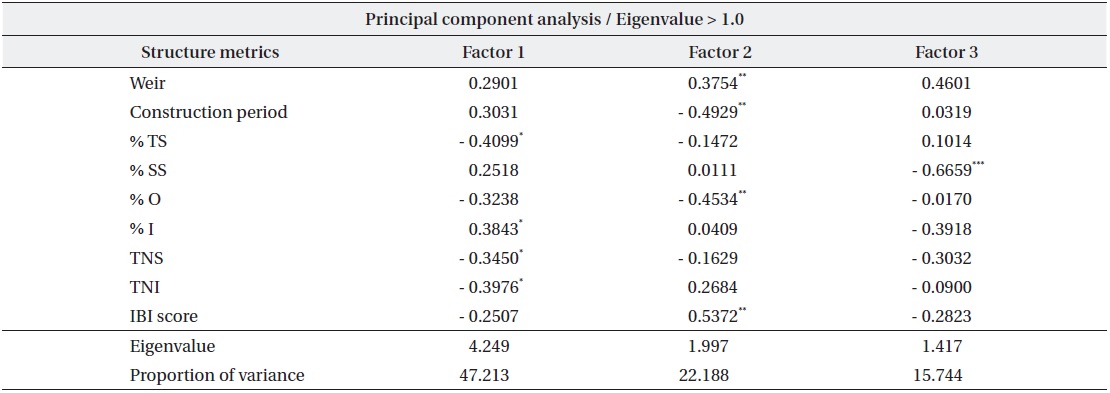
Principal component analysis (PCA), based on tolerance guilds (TS, SS), trophic guilds (O, I), fish composition (TNS, TNI), multi-metric IBI mode values, and the physico-chemical parameters. The abbreviations are as follows; SS = Sensitive Species, TS = Tolerance Species, O = Omnivore Species, I = Insectivore Species, TNS = Total number of species, and TNI = Total number of individuals
In addition, we also tried hierarchical cluster analysis per study site using parameters in PCA and it could divide with 2 groups from total 12 sites of each three weir region in Geum-River watershed (Fig. 7). Group I was classified to sites studied before the weir construction (Bwc, 2008 - 2009) with high IBI values. While, Group II was studied after the weir construction (Awc, 2011 - 2012) with decreased IBI values. These results were similar to pattern analysis using SOM. It was divided by the periods of weir construction remarkably, and showed decrease of the IBI score.
Overall, our results suggest that partial chemical changes were evident after the weir construction. Especially, total phosphorus (TP) in the epilimnion (surface water) decreased significantly (
